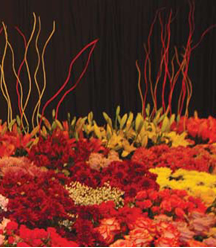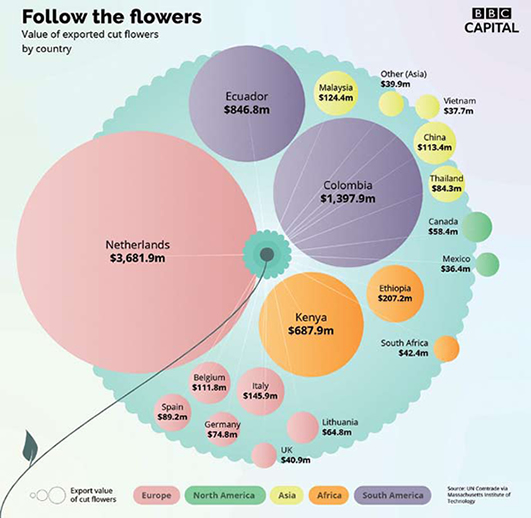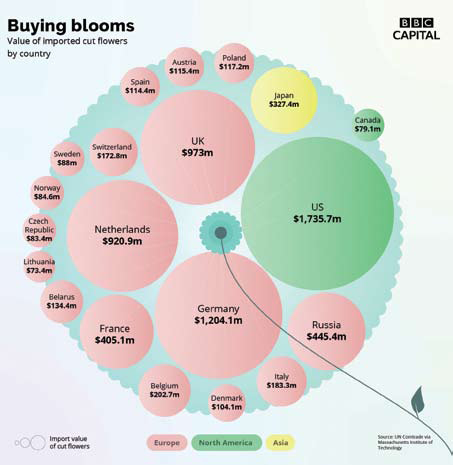By Bryan Lufkin
 Why does something you could just pluck out of the ground cost so much?
Why does something you could just pluck out of the ground cost so much?
There are several reasons: flowers are delicate, high maintenance, perishable, difficult to grow, often imported and can cross continents as they make their way from field to florist.
So as 12 May approaches – Mother’s Day in nearly 100 countries – you may find yourself grumbling about how much a bouquet costs. But that price tag has to account for the house-of-cards nature of the product: the time and money farmers spend to hit holiday deadlines and the pressure for florists to match supply to demand, or lose out.
Mother’s Day and Valentine’s Day tend to be big flower holidays, pressuring growers and florists to hire extra help – thus bumping up the price tag.
High-risk peaks
Perfect blooms are extremely fragile – both physically and from a business perspective. And when it comes to flowers grown to hit holiday peaks, both farmers and florists face higher labour costs and financial risks. A big driver behind this is the fact that so many countries import their flowers.
According to research from Comtrade, the United Nations’ international trade database, global exports of cut flowers were worth $8.48bn in 2017, a 46% increase from 1995. (“Cut flowers” refers to flowers presented in bouquets, like roses, lilies, tulips and pansies.) The Netherlands was the top exporter, followed by developing countries like Colombia, Ecuador, Kenya and Ethiopia. Ecuador and Colombia exported the most roses and carnations in 2018, Thailand topped the orchid trade while Colombia dominated with lilies and chrysanthemums.

Top importers are almost exclusively developed countries: the US, Germany, the UK, the Netherlands and Russia. Amy Stewart, author of Flower Confidential, a behind-the-curtain look at the industry, says almost all the blooms bought in the developed world are imported.
“They’re moving across continents and since they’re perishable, they have to be refrigerated as they travel, which is expensive. For florists, it can be risky, because they may order 10,000 tulips in hopes of selling them for a lone event on the calendar, like Mother’s Day. But if they don’t sell them all, the leftovers quickly die and become worthless. Part of what consumers are paying for is that risk.”
Labour surges
Hitting those peaks requires precision and skill. The flowers must be grown in such a way that they don’t develop diseases or pests, which could potentially spread through entire crops. Mr. Raphael Mulinge, who has been growing flowers for 20 years in Kenya, points to insect damage as a big challenge, saying there’s a “zero tolerance” policy: “It is through constant vigilance and the use of integrated pest management that we keep the little buggers from getting the best of our crops,” he says.
Then the flowers have to bloom on schedule. In the case of valentine’s Day roses have to bloom by early february in time to be picked and shipped.
The big reason cut flowers can be so expensive is because they go through so many delicate stages on the supply chain.
Labour costs are already high contract and hired labour accounted for 10% of total agricultural operating expenses, but that number is soaring to 40% for greenhouse and floriculture production because of a tighter farm labour market and rising wages. Then you add extra costs for peaks.
Most farms hire extra hands during peak periods but says cutting flowers “requires experience and cannot be done by just any part-time employee”. Chris Drummond, a Philadelphia-based florist, says wages average around $13.25 (£10.16) per hour in the US. “In order to ramp up production to meet holiday demand, growers are required to pay far above that average,” he says.
In developed countries like the Netherlands or Germany, Stewart says that there are greenhouses with automated technology like sophisticated watering machines or robot transplanters and harvesters, where fewer workers are needed. But in poorer nations with cheaper labour, there’s less use of technology.
Then it’s time for shipping. While flowers are waiting on the runway or in the back of a lorry, temperatures can’t be too cold (for Valentine’s Day) or too hot (for Mother’s Day). When they arrive at the wholesaler, they must look perfect. That means no bug bites, no missing petals, no dead buds. Otherwise, they get thrown away. “It has to be flawless,” Stewart says.
Besides many being shipped from continents away in refrigeration, flowers must be devoid of even tiny flaws, like small bug bites or discolourations.
Complicated logistics  Chris Drummond, the florist, estimates that the holiday volume “is usually nearly 20 times the everyday volume”. He says many farmers nurture flowers all year long to ensure enough blooms for the handful of holidays. During the other months on the farm, he says, flowers are sold at cost, below cost or discarded and turned into mulch.
Chris Drummond, the florist, estimates that the holiday volume “is usually nearly 20 times the everyday volume”. He says many farmers nurture flowers all year long to ensure enough blooms for the handful of holidays. During the other months on the farm, he says, flowers are sold at cost, below cost or discarded and turned into mulch.
“So, of course farm price increases as demand increases,” he says. “Consumers are paying a premium to make sure that grower is compensated for their expense and effort to maintain the plants yearround, thus ensuring the wide variety of flowers is available at each holiday.” He highlights costs across the supply chain, saying industry participants must “rent temporary space, pay fuel surcharges, find space on airlines, hire independent drivers, find more refrigerated trucks, pay overtime to staff” and more. Roses flown from Nairobi to Amsterdam are hit withextra fees to clear the extra expenses. Domestic refrigerated transport can vary, but that’s extra fees per rose. It also depends on what kind of flower you’re shipping a grower says 300 carnations can fit into the same box as 150 roses, so the transport price per stem is halved. Transit time from field to florist can be up to a week (though it can wildly vary depending on where the flowers are coming from), and the blooms must be carefully handled every step of the way.
Mr. Craig is a cut flower grower in Kenya and has been growing since 1980s. His biggest challenge? “Time. There is never enough time,” he says. “Between seeding, planting, harvesting, marketing, selling and accounting this job is basically five full-time jobs rolled into one low-paying job.”
He points to the fickle nature of what’s in fashion as an additional challenge: “Flower popularity is a lot like fashion as colour, shapes, textures change almost on the whim. Keeping up on social media and growing forums is must to understand it all. Roses are extremely popular at the moment as it photographs so well, and they have so many colours and shapes.”
Finally, it’s time to order that bouquet – but again this can ratchet up the price tag, because florists who are often highly trained will work their magic to deliver a professional, personalised display that will keep the customer coming back. Stewart has a tip – don’t set out what you want in the bouquet but give the florist room to excel, and you’ll end up with better value for money. “It’s a far better thing to say, ‘You know, I want to get some flowers for my mum. She loves Italy, she goes to Tuscany all the time – I want something that looks like it came out of the Italian countryside,” she says.
Origin stories
Given the challenges, logistical demands and skill levels needed across the supply chain, it’s no wonder flowers cost as much as they do. But some within the industry say it’s a matter of getting consumers to realise the amount of work that goes into one bouquet.
Debra Prinzing, a former home and garden journalist in Seattle who’s an advocate for growing and selling local flowers, says shifts in the flower industry mirror the evolution of the food industry a few decades back. She gives the example of a chef sharing a colourful story about where the truffles in a particular dish came from; she wants people to prize flowers and their origin stories in the same way rather than seeing them as simple consumables.
“I think flowers have incredible value when you have that connection to a human farmer who grew them,” she says. And learning how to appreciate just how much time, effort and risk go into that special bouquet could help you better digest the cost.
“Those flowers have passed through more hands, maybe travelled through more countries, might have been talked about in more languages, might have been haggled over in more currencies, and are better traveled than you on your last summer vacation,” Stewart says. “It is so incredibly complex behind the scenes.”
